GUN TESTS GRADE: A-
$373
The SU22CA is a typical KelTec rifle design that sandwiches the action between two halves of a polymer receiver. The SU22CA design holds everything together with 12 screws. It looks a bit Frankensteined, but we found what this mini-monster lacked in beauty it made up for in performance. It was the lightest rifle, weighing 4 pounds unloaded. It also had mystery controls, meaning the safety and bolt lock were not readily apparent with the first look.
| Action | Semi-auto, blowback |
| Overall Length | 34.0 in. |
| Disassembled Length | 24.5 in. |
| Overall Height (w/o optic) | 10.0 in. |
| Weight Unloaded | 4.0 lbs. |
| Weight Loaded | 4.2 lbs. |
| Barrel Length | 16.1 in. |
| Barrel | Blued steel |
| Receiver | Matte-black polymer |
| Buttstock | Textured black synthetic, serrated buttpad, sling studs |
| Buttstock Length of Pull | 13.5 in. |
| Magazine | (1) 26-round detachable |
| Front Sight | Steel post |
| Rear Sight | Adjustable aperture |
| Trigger-Pull Weight | 7.6 lbs. |
| Safety | Manual hammer block |
| Warranty | Lifetime limited |
| Telephone | (321) 631-0068 |
| Website | KeltecWeapons.com |
| Made In | U.S.A. |
The SU22CA has a similar design as the KelTec SU-16C, which is chambered in 5.56 NATO, and we suspect KelTec uses some parts interchangeably between the two platforms, such as the stock, trigger group, and receiver. The SU22CA is a simple blowback action; the SU-16C uses a gas-piston system. They are very different mechanisms. A recoil spring tube is positioned above the barrel and brings the bolt into battery after a shot is fired and the empty case ejected.
The SU22CA does not have an automatic bolt stop, so the bolt will not lock back after the last round in the magazine is fired. We missed the bolt-hold-open feature. You can lock the bolt back manually by pulling the operating handle back and holding it, then press the mystery button and hold up on the bolt stop and slowly release the bolt handle. At first glance, the button looked like smooth steel and that it was part of the receiver. Little did we know that we needed to read the manual to discover it was a button, hence the mystery button nickname. The bolt stop does not look like a button; instead it is located between the forward part of the trigger guard and behind the mag well. The charging handle is a knurled metal tube that offers plenty of leverage and texture.
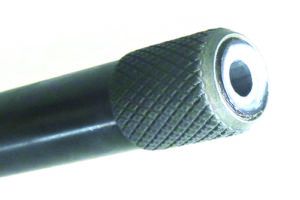
In the cardboard box was a smoke-colored polymer 26-round magazine X-Form manufactured by Black Dog Machine. It is the size of an AR-15 magazine. You could see inside the magazine, so it was easy to tell when you needed to fill up. Also in the box was a pin that required the new owner to insert it into the pistol grip to keep the trigger group secure to the receiver. We gorilla-ed the trigger group and the receiver together, and with the polymer being flexible, we were able to insert the pin. The assembly pin is removed when field stripping and cleaning the gun. We dropped it on the shop floor. Needless to say, we lost the assembly pin as easily as a week’s pay in Vegas.
There was also a stumpy winged Phillips screwdriver in the box to adjust the rear sight. The front sight is attached to the recoil spring tube and is an adjustable post similar to an AR-15 A2 sight post.
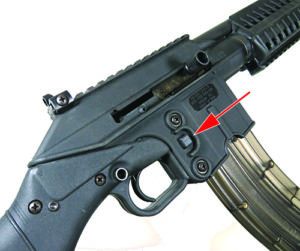
The molding seam on the polymer was very pronounced and almost afforded as much gripping texture as the serrations molded into the pistol grip. The skeleton stock looked flimsy, but in fact was fairly rigid and stiff. The butt was serrated. A button under and behind the pistol grip is pressed to fold the stock downward. The stock will fold and click into place, so there is no fear it will become loose and swing out on its own. When in the folded position, you can insert the 26-round magazine and fire the rifle. You need to remove the 26-round magazine, however, to extend the stock. Folding the stock is not intuitive, and users who did not read the manual pinched their fingers the first time. Still, the process of folding and unfolding the stock becomes rote and quick with practice. The rifle measured 24.6 inches in overall length with the stock folded.
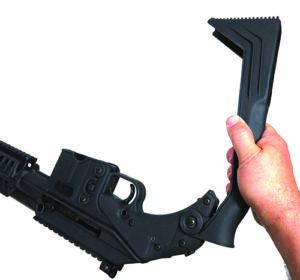
The forend is held in place by a large nut encased in polymer. Remove the nut and the forehand slides toward the muzzle and off the rifle. While the forend looks like a quad rail, it is smooth with ridges, so it offers a good grasp. There are plenty of holes and square cutouts to allow the barrel to cool. Another rail is molded into the bottom of the forend to mount a foregrip, light, or laser.
The receiver’s magazine well is similar to an AR-15’s, and the magazine release is in nearly the same place as an AR-15. It is a small square button that is easy to operate with a right-handed shooter’s trigger finger. We would have liked a bit of texture on it for a no-slip press. The plastic magazine inserted with ease and dropped free when the button was pressed. The magazine fell on the concrete deck a few times and survived with no cracks.
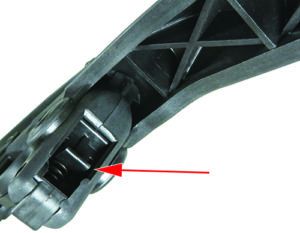
A crossbolt safety is located behind the trigger, and it blocks the trigger. We found it easy enough to operate, though from the right side the button looks like a short tube (another mystery button), and from the left side it looks like a traditional crossbolt safety button.
The trigger is serrated and made of polymer. Pull weight was a creepy 7.6 pounds. There was a bit of take up, and in fact, the trigger clicks after take-up and then releases the hammer. Not the best trigger for precision work, but serviceable for the rifle’s intended purpose. The topside of the receiver has a molded Picatinny-style rail. A rear aperture sight is held in place by a two small plastic C-clamps held in place by Phillips-head screws, hence the need for the stubby screwdriver that was in the box. The barrel is threaded and covered with a knurled thread protector, which could easily be removed with your fingers.
Going hot, we found the magazine had polymer feed lips and was possibly the easiest 22 rimfire magazine we have ever loaded. We found it was easy to run the SU22CA like an AK, grasping the bolt from the underside of the rifle with our support hand while our shooting hand grasped the pistol grip. The sights are by no means precision, but they give a good sight picture. We found the sights needed adjustment and used the supplied Phillips screwdriver to adjust the windage. With the two screws on the sides of the rear sight, you need tighten the screw on the same side of the rear sight that you want to move the point of impact to and loosen the screw on the opposite side. We thought this was crude but effective.
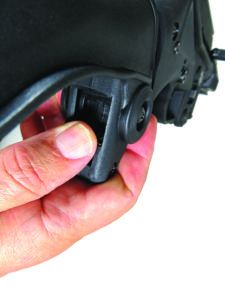
At the range, we had no issues. The KelTec ran well, and our best group was with 36-grain Winchester Xpert HV ammo, which measured 1.06 inches for five shots at 25 yards. Federal Auto Match ammo had the next-best group that measured 1.26 inches. The rest of the ammo groups of five shots came in at 1.5 inches, on average. Muzzle report was mild, as was recoil. We did notice you could make the stock flex if you gorilla-ed the rifle, but the polymer sprung back to shape.
Our Team Said: The SU22CA is a nice but ugly rifle that performed well. We know a red or green dot sight helps shrink groups. We weren’t in love with the trigger, but we were able to squeeze out fairly decent accuracy. We liked the ability to fire the rifle with the stock folded. We also felt the utilitarian design was well suited for a camp/canoe/truck gun or bug-out bag. It was the longest when collapsed, but weighed the least even when fully loaded.
22 LR Range Data
| Winchester Xpert HV 36-grain HP | KelTec SU22CA | Ruger 10/22 Takedown | Savage 64 Takedown |
| Average Velocity | 1236 fps | 1250 fps | 1277 fps |
| Muzzle Energy | 122 ft.-lbs. | 125 ft.-lbs. | 130 ft.-lbs. |
| Smallest Group | 1.06 in. | 0.74 in. | 0.74 in. |
| Average Group | 1.09 in. | 0.82 in. | 0.76 in. |
| Federal Auto Match 40-grain LRN | KelTec SU22CA | Ruger 10/22 Takedown | Savage 64 Takedown |
| Average Velocity | 1133 fps | 1143 fps | 1103 fps |
| Muzzle Energy | 114 ft.-lbs. | 116 ft.-lbs. | 108 ft.-lbs. |
| Smallest Group | 1.26 in. | 0.68 in. | 0.69 in. |
| Average Group | 1.38 in. | 0.71 in. | 0.73 in. |
| CCI Blazer 38-grain LRN | KelTec SU22CA | Ruger 10/22 Takedown | Savage 64 Takedown |
| Average Velocity | 1218 fps | 1229 fps | 1224 fps |
| Muzzle Energy | 125 ft.-lbs. | 127 ft.-lbs. | 126 ft.-lbs. |
| Smallest Group | 1.34 in. | 1.12 in. | 0.37 in. |
| Average Group | 1.40 in. | 1.22 in. | 0.39 in. |
| Remington Thunderbolt 40-grain LRN | KelTec SU22CA | Ruger 10/22 Takedown | Savage 64 Takedown |
| Average Velocity | 1163 fps | 1197 fps | 1183 fps |
| Muzzle Energy | 120 ft.-lbs. | 127 ft.-lbs. | 124 ft.-lbs. |
| Smallest Group | 1.48 in. | 0.76 in. | 0.43 in. |
| Average Group | 1.50 in. | 0.81 in. | 0.50 in. |
Related Articles
Savage Model 64 Takedown 40207 22 LR
Ruger 10/22 Takedown 11100 22 LR




























had this rifle for a long while now but over the years there hasn’t been a lot of articles written on it. I really appreciate your thorough work. bravo!